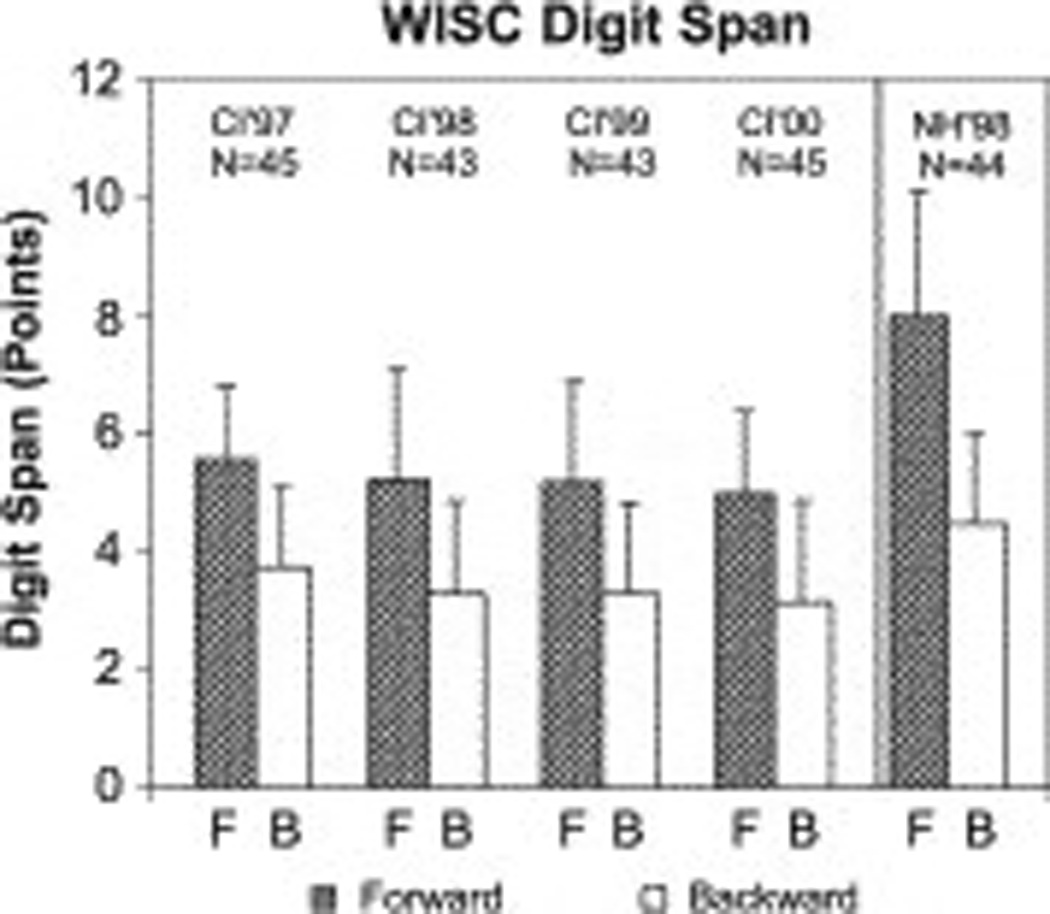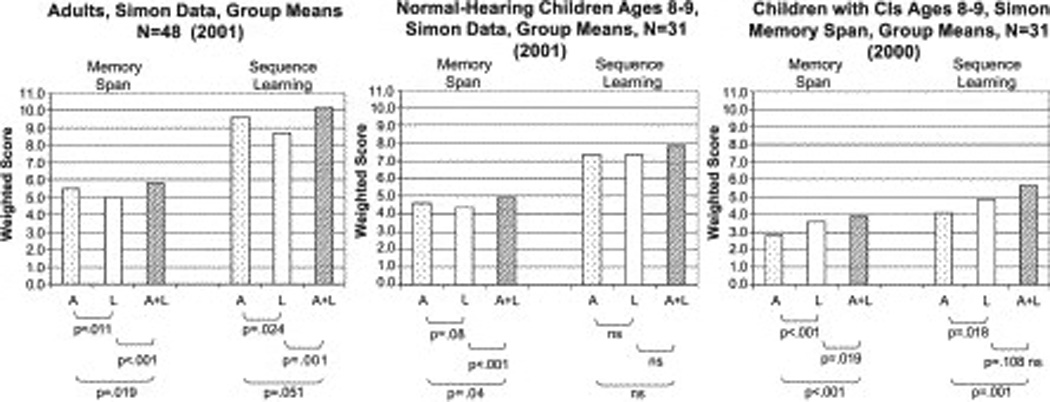Abstract
Recent findings on learning, memory and cognitive processes in deaf children following cochlear implantation are reviewed. The contribution of demographic factors is discussed and the results of several studies using “process” measures of performance are presented. In the first study, results from an investigation of the “Stars” showed that the exceptionally good implant users differed from the low performers in several important ways reflecting their ability to rapidly encode sound patterns into phonological representations. In the second set of studies, several new measures of information-processing performance are reported. Speaking rate, a measure shown in other populations to correlate well with an individual’s verbal rehearsal speed for items in immediate memory was found to be strongly correlated with measures of a child’s immediate memory capacity as well as open-set spoken word recognition scores. Additional evidence revealed atypical reproductive memory spans for auditory as well as visual sequences. Deaf children with cochlear implants also showed less benefit from simple repetition of a familiar sequence than age-matched normal-hearing children. Variation in children’s success with cochlear implants reflects differences in the operation of elementary information-processing skills used in a wide range of language-processing tasks that draw on phonological coding and verbal rehearsal processes.
Keywords: Speech perception, Cochlear implants, Phonological-processing skills, Working memory, Verbal rehearsal, Sequence memory
1. Introduction
I have been studying the enormous individual differences and variability in speech and language outcome measures reported in deaf children with CIs [1]. Why are some children doing so well with their CIs while others struggle and perform more poorly? How can we explain for these differences in outcome and benefit? What underlying factor or set of factors are responsible of these large differences in performance on a wide range of behavioral tests? If we can identify the reasons why a “good” child is performing so well, we should be able to use this basic knowledge to help poorer performing children improve their speech and language skills.
What do we know about outcome and benefit in deaf children with CIs? Table 1 lists seven key findings observed universally at all implant centers around the world. An examination of these findings indicates that several demographic and medical factors contribute to outcome and benefit following implantation. However, there are still substantial gaps in our basic knowledge of how CIs work. Moreover, several other sources of variability have also been found to contribute to outcome. These sources of variability reflect cognitive and neurobiological factors that constrain the basic information-processing capabilities of children. These factors involve the sensory and perceptual encoding of sound into speech and the storage and processing of phonological and lexical information in short-term memory. There are also several linguistic factors that reflect the use of common phonological representations in a range of behavioural tasks that are routinely used to assess speech and language outcomes.
Table 1.
| Seven Key Findings |
|---|
| • Large individual differences |
| • Age of implantation (sensitive periods) |
| • Effects of early experience (Oral vs. TC) |
| • Cross-modal plasticity |
| • Links between perception and production |
| • Abilities emerge after implantation (learning) |
| • No preimplant predictors of outcome |
One of the major problems with CIs in profoundly deaf children is that CIs do not work in all patients to the same degree. Some children do extremely well with their CIs while other children do more poorly. At the present time, we do not know why there is so much variation in outcome and benefit after CI.
We are not only interested in whether deaf children with CIs are able to “hear” via their CI. We want to understand what they are able to do with the sensory information they do hear. How do these children construct phonological representations of the input signals they hear? What kinds of linguistic representations do they create? Are their phonological and lexical representations “fully specified” like normal-hearing typically developing children or are they significantly “underspecified” reflecting more primitive coarse-coding strategies and the use of broader phonetic categories.
In addition to directly addressing pressing clinical problems surrounding variation in outcome and benefit following cochlear implantation, important questions that deal with the “effectiveness” of CIs as a treatment for profound deafness, basic research on congenially deaf children with CIs can also inform us about the effects of sensory deprivation and the consequences of restoring hearing after cochlear implantation. Deaf children with CIs represent a unique clinical population that can provide important new knowledge about the effects of early experience and activity-dependent learning on neural development.
2. Results and discussion
2.1. Analysis of the “Stars”
Using an extreme groups design, we sorted a large group of deaf children with CIs into two categories based on their PBK phoneme scores and then examined their performance on several different speech and language outcome measures [1]. Three findings emerged from these analyses. First, we found that PBK and LNT word recognition scores were highly correlated, a result suggesting that these tests are measuring the same basic underlying linguistic skills. Second, we found that the “Stars” recognized spoken words “relationally.” They recognized lexically easy words better than lexically hard words and shorter words better than longer words. Finally, we found that the speech and language outcome measures in the “Stars” were all highly inter-correlated with each other suggesting a common underlying source of variance related to the use of phonological-processing skills in these tests. The same patterns were not observed with the low performers.
2.2. Immediate memory capacity
The information-processing capacity of immediate memory in children with CIs was measured in another study using WISC digit spans [1]. Fig. 1 shows that forward digit spans, which reflect phonological coding and verbal rehearsal, were “atypical” compared to a group of age-matched normal-hearing children. Forward digit spans were shorter for children with CIs than NH children shown on the right.
Fig. 1.

Mean WISC digit spans scored by points for the four groups children with CIs and for a comparison group of normal-hearing children. Forward digit spans are shown by the shaded bars.
2.3. Verbal rehearsal speed
Estimates of the verbal rehearsal speeds of deaf children with CIs were obtained by measuring speaking rates using sentence duration [1]. The results revealed slower verbal rehearsal speeds compared to age-matched NH children. As shown in other populations, verbal rehearsal speed was also strongly correlated with immediate memory capacity as well as several independent measures of spoken word recognition.
2.4. Scanning of STM
Several measures of speech timing during the digit span recall task were also analyzed to investigate retrieval and scanning of information in STM and speed of articulation at output. Scanning of familiar digits was significantly slower for the children with CIs, suggesting less robust perceptual encoding and maintenance in STM.
2.5. Sequence memory and learning spans
Using a novel memory game, we measured reproductive memory spans for auditory (A), visual (L) and auditory+visual (AL) sequences [2]. Fig. 2 displays a summary of the major results. As shown on the left of each panel, children with CIs displayed shorter memory spans than NH children and adults. They also showed lower redundancy gains in the A+L condition and a reversal of the modality effect found with the NH children and adults. As shown on the right in each panel, when the patterns were repeated to measure sequence learning effects following repetition, we found that the sequence learning spans were much shorter for children with CIs than NH children. In fact, about one third of the children with CIs failed to show any sequence repetition effect or benefit. This result was observed across all three presentation conditions indicating the presence of significant differences in simple sequence learning based on pattern repetition that are not modality specific.
Fig. 2.

Mean reproductive memory spans and learning spans for each of three presentation conditions using the “Simon” memory game task. Speckled bars indicate scores in the auditory-only (A), open bars indicate scores in the light-only (L) and shaded bars indicate scores in the auditory-plus-lights (A+L).
3. Theoretical and clinical implications
What is the common underlying factor that links these various sets of findings together? We propose that the development and efficient use of phonological-processing skills is a significant contributor above and beyond the traditional demographic variables that have been shown to affect outcome and benefit following CI. Phonological analysis involves the rapid decomposition and recoding of a continuous speech waveform into a sequence of discrete meaningless segments or “particles” and the assignment of a structural description to the sound pattern that reflects the linguistically significant sound contrasts of the words in the target language. For many years, open-set tests of spoken word recognition performance have been considered the “gold standard” of outcome and benefit following CI by both clinicians and researchers. The reason this is true is because open-set tests load heavily on the component processes of speech perception, verbal rehearsal, scanning and retrieval of phonological segments from STM during reassembly and phonetic implementation required for speech production and response output.
References
- 1.Pisoni DB, et al. Individual differences in effectiveness of cochlear implants in prelingually deaf children: some new process measures of performance. Volta Rev. 2000;101:111–164. [PMC free article] [PubMed] [Google Scholar]
- 2.Pisoni DB, Cleary M. In: Learning, memory and cognitive processes in deaf children following cochlear implantation. Zeng FG, Popper AN, Fay RR, editors. vol. X. Handbook of Auditory Research: Auditory Prosthesis: Springer; 2004. SHAR. [Google Scholar]


